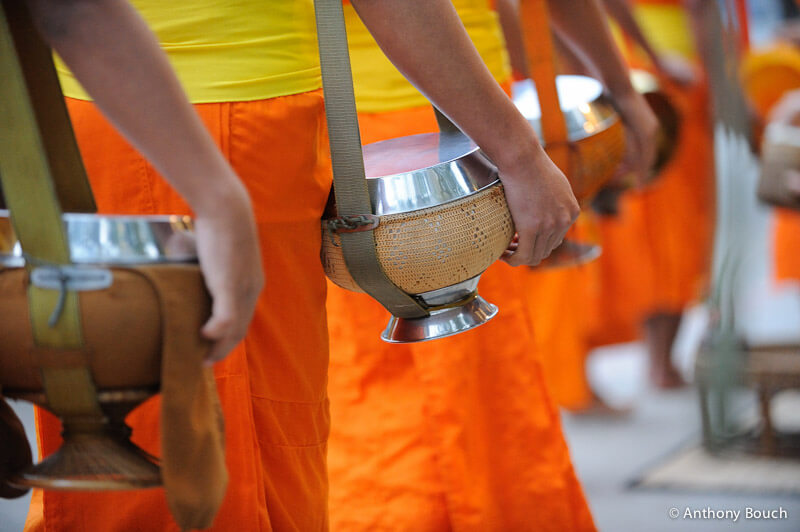03 Jun / Consider the Bowl

In Asian cuisine, the bowl is ubiquitous as a receptacle for food.
In Japanese tradition, donburi refers to both the dish and the oversized bowl that contains the rice topped with various ingredients.
Korean bibimbap comprises a bowl of rice topped with an assortment of kimchi, seasoned vegetables and/or grilled meats, and often a fried egg.
Many Southeast Asian countries have noodle dishes served in bowls: Thailand’s khao soi (red curry noodles), Indonesia’s bakmi ayam (noodles with chicken) as well as Singapore’s mee siam (spicy, sweet and sour noodles), to name a few.

A modern take on an Asian noodle bowl: Sesame Noodles with Thai Green Curry Tofu, Red Cabbage and Snap Peas from Great Bowls of Food (Photo credit: David Schmit)
You may have also heard of Buddha bowls. This term very likely stems from the practice of Buddhist monks in Asia who head to the closest village every morning to receive alms. As they walk in neat saffron lines, they hold out their bowls for villagers to scoop out rice and other dishes. The resulting medley is a mix of rice and vegetables composed, layered and piled on top of each other, and will sustain the monks throughout the day.

Monks receiving alms in the early morning of Luang Prabang. (Photo credit: Anthony Bouch via Flickr, CC)
In her new cook book, Great Bowls of Food: Grain Bowls, Buddha Bowls, Broth Bowls, and More(The Countryman Press, May 2016), Robin Asbell writes, “The bowl is more than just a place to put cereal. It can be a gateway to the practice of mindful eating. It can be a blank canvas for your spontaneous creativity. Or it can be a comforting cradle in which to pile your favorite flavors. It’s up to you.”

Whether you like to follow recipes or improvise, this wonderful book will show you how to make meals everyone will love.
Asbell states that “your daily bowl can be as simple as a bowl of leftover grains, topped with whatever vegetables are in your fridge, some leftover beans or seeds (or protein), and a drizzle of tamari.”
While Asbell offers up many different recipes for breakfast, lunch and dinner, she also gives tips for improvising. This is great because even the pickiest family member can customize their own bowl to meet their needs.

I made this rice bowl with leftovers plus whatever I had in my pantry–wild rice medley, bok choy kimchi, sauteed zucchini, daikon pickles, scrambled eggs and toasted nori. So delicious!
To build your own bowls, here are 4 guiding steps . Don’t be too set on getting a perfect combination. Take your cue from the Japanese–a meal is not complete until these five colors are represented: black white, green, red and yellow. In the U.S., we often encourage kids to “Eat the Rainbow.” You can’t go wrong with either recommendation!
- Pick a Base
Start with a base that can range from grains (rice, quinoa, oats), vegetables (cauliflower “rice,” zucchini “noodles.”) or noodles (wheat, egg, rice, buckwheat.)
- Pick Toppings
Vegetables: stir-fried, steamed, pickled, fermented
Protein: tofu, fish and meats, whether leftover, cured, canned or grilled.
Dairy: egg, yogurt or cheese.
- Pick a Sauce
Condiments can range from a teriyaki-like mix of water, soy sauce, sugar, and mirin, Korean gojuchang, or simply a squirt of sriracha. Then there are numerous broths to choose from.
- Pick a Garnish
Choose from any of the following groups:
Colorful: shredded carrots or red peppers, herbs like basil and cilantro
Crunchy: nuts, seeds, fried shallots, fried garlic
Umami-packed: sea vegetables like nori or wakame
Happy composing!
~~~
[yumprint-recipe id=’29’]






Delicatessen!!